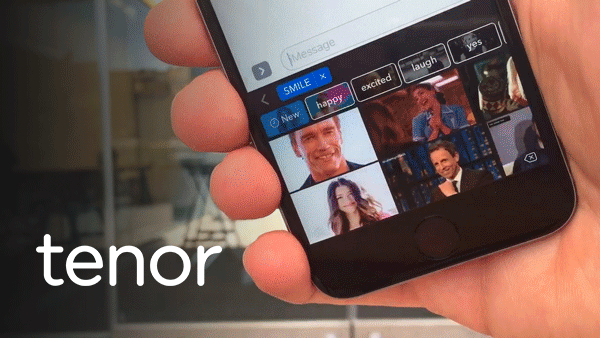GIFs may be a popular way of communicating as the way we talk to each other increasingly shifts to mobile, but really it’s about communicating in some form of video. We’re seeing video become more and more prevalent on mobile devices, and GIFs just happen to be a convenient way of doing that, Riffsy CEO David McIntosh says.
At its core, using video to communicate can serve a stronger purpose beyond just text and photos. It’s easier to communicate certain feelings and emotions using video throughout communication, and thanks to that, GIF-loaded keyboards have become increasingly popular. That includes Riffsy, which today is changing its name to Tenor to better suit its goals: giving people a way to communicate emotions through video, starting off with GIFs in a keyboard.
Today, the company is also rolling out a new development kit that will allow third-party developers to tap into those tools when working on their own communications services. The first partner that’ll be using the new SDK is TouchPal, which is integrating features like its GIF search into the keyboard. Tenor’s GIF Keyboard has hit around 150 million people making queries every month, McIntosh said. That’s distributed across all the networks where the keyboard touches
“I have this thought, feeling trapped in my head, I want to send it to you and communicate it to you, and I get this visual object,” McIntosh said. “GIFs i think are now just shorthand for a portable video object. Theres that element of clarity and precision to it. [Mobile is] where people are communicating the most. GIFs have been this toy on the web for the last 20 years, and people have a short fun way of capturing a laugh. But on mobile — fun is certainly part of it, any consumer product needs fun — the pain point it solves is around communication.”
Tenor has already worked with multiple partners when it comes to GIF search, like Kik. This new SDK further opens up that potential web of developers it will work with, making it easier to collect more data and improve its own services (the GIF Keyboard app) and get more people contributing content. As more and more developers start using it, that creates a virtuous cycle where Tenor gets more data on how people are communicating with GIFs. Then it gets better targeting, prompting more developers to consider using it because it can increase the net engagement of their services, and so on and so forth.
There’s a good reason to open up tools like this, even if it might strip away autonomy and keep audiences from either discovering or gravitating toward the core GIF Keyboard app. Many of the best use cases for services are actually discovered by third-party developers or users, who may end up bending the app in ways the original creators may not have anticipated to accomplish what they’re trying to do. Opening up to developers casts a wider net to capture all use cases and keep people locked into the ecosystem.
It also helps Tenor expand internationally. While there’s already a lot of international usage — video tends to be a better mechanism for communication than text, which is capable of being language independent, McIntosh said — each new keyboard and tool that’s popular internationally helps Tenor understand how international users behave. It can then tune parts of the service to cater to those international users.
That’s important for Tenor, which also has to make sure it’s getting the right information in front of users at the right moment — or risk losing them to competing tools and services. McIntosh said users generally don’t scroll past the first four to eight GIFs on a keyboard, so it’s important to ensure that the theme they are looking for lands in that first section.
Competition will, of course, be steep. Its primary competitor, both in spirit and in practice, is Giphy — which recently raised $55 million at a $300 million valuation. There’s also probably plenty of room for more than one option, given the popularity of multiple different kinds of keyboard applications and the constant emergence of new ones like Google’s GBoard. But if Tenor can continue to expand its footprint beyond a simple independent keyboard application, it may find itself figuring out how people not only use GIFs but also how they are thinking about video as a mechanism for communicating on mobile devices.
